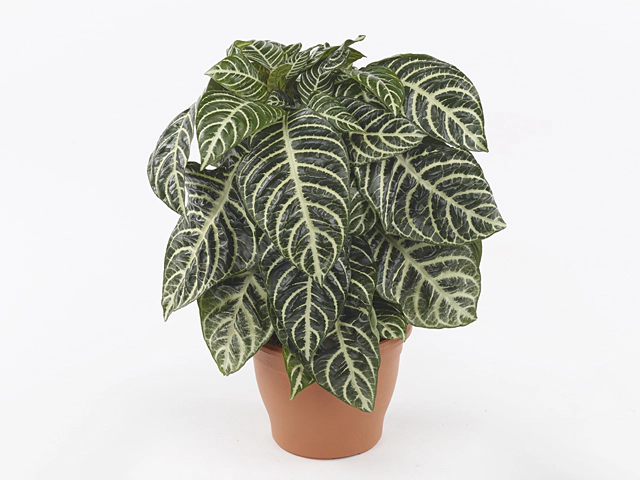Aphelandra squarrosa

| Leaf arrangement | crosswise opposite |
| Leaf tip | Pointed/acute |
| Leaf margin | Entire |
| Leaf, general shape | Ovate (egg-shaped) |
| Leaf, scent | Unscented |
| Plant height | 20 - 30 cm |
| Structure (tissues) | Herbaceous |
| Leaf width | 7,5 - 10 cm; 7,5 - 10 cm |
| Leaf surface | Glossy; Bullate |
| Leaf size | 15 - 20 cm |
| Leaf division | Simple |
| Plant, growth type | Erect |
| Leaf, main color | Yellow-light yellow-150D; Green-dark green-139A |
| Leaf colour, pattern | Bicolored; Striate |
The Zebra Plant, scientifically known as Aphelandra squarrosa, is a visually striking plant that is sure to grab attention with its unique leaf pattern. Native to the tropical rainforests of Central and South America, this plant has become a popular choice for indoor gardens and houseplant enthusiasts.
One of the standout features of the Zebra Plant is its distinct leaf arrangement. The leaves are crosswise opposite, meaning they grow in pairs directly across from each other on the stem. The leaf tips are pointed or acute, giving the plant a sense of elegance and sharpness.
The shape of the leaves is ovate, resembling the shape of an egg. They have a smooth and glossy surface, which adds to their attractive appearance. The leaves can grow to be around 15-20 cm in size, with a width varying between 7.5-10 cm. These measurements, paired with their bicolored and striate pattern, create a visually appealing contrast of yellow and dark green shades.
The Zebra Plant is classified as an herbaceous plant, meaning it has soft and non-woody tissues. This characteristic allows it to be flexible and adaptable to different environments. The plant typically grows to a height of 20-30 cm, making it a relatively compact choice for indoor spaces.
In terms of care, the Zebra Plant prefers bright but indirect light. It should be placed near a window where it can receive filtered sunlight. They also have a preference for high humidity, so misting the leaves regularly or placing the plant on a tray with water can help create the optimal conditions for growth.
As for watering, it is best to keep the soil moist but not waterlogged. Overwatering can lead to root rot and other issues, so it's important to allow the top inch of soil to dry out between waterings. Fertilizing the plant every 2-4 weeks during the growing season with a balanced houseplant fertilizer can also help promote healthy growth.
The Zebra Plant does not have a noticeable scent, which may be a relief for individuals who are sensitive to strong odors. This makes it an ideal choice for those looking for an attractive addition to their home or office without compromising on fragrance.
Overall, Aphelandra squarrosa, or the Zebra Plant, is a stunning houseplant known for its bold and eye-catching leaf pattern. With proper care and attention, this plant can thrive indoors, adding a touch of unique beauty to any space.
Market availability index by month:
| Jan. | Feb. | Mar. | Apr. | May | Jun. | Jul. | Aug. | Sep. | Oct. | Nov. | Dec. |
|---|---|---|---|---|---|---|---|---|---|---|---|
| 3 | 3 | 3 | 3 | 3 | 3 | 3 | 4 | 3 | 3 | 3 | 3 |